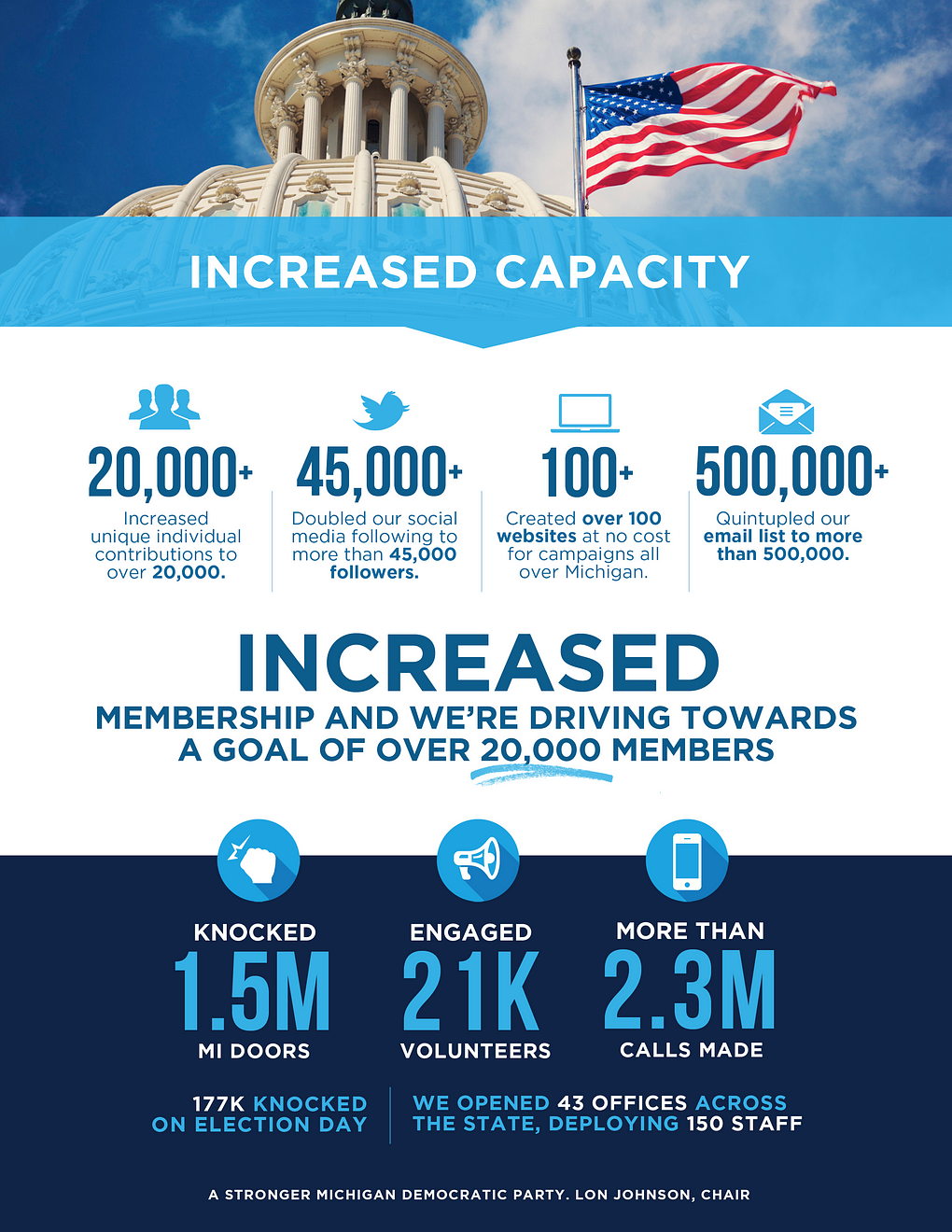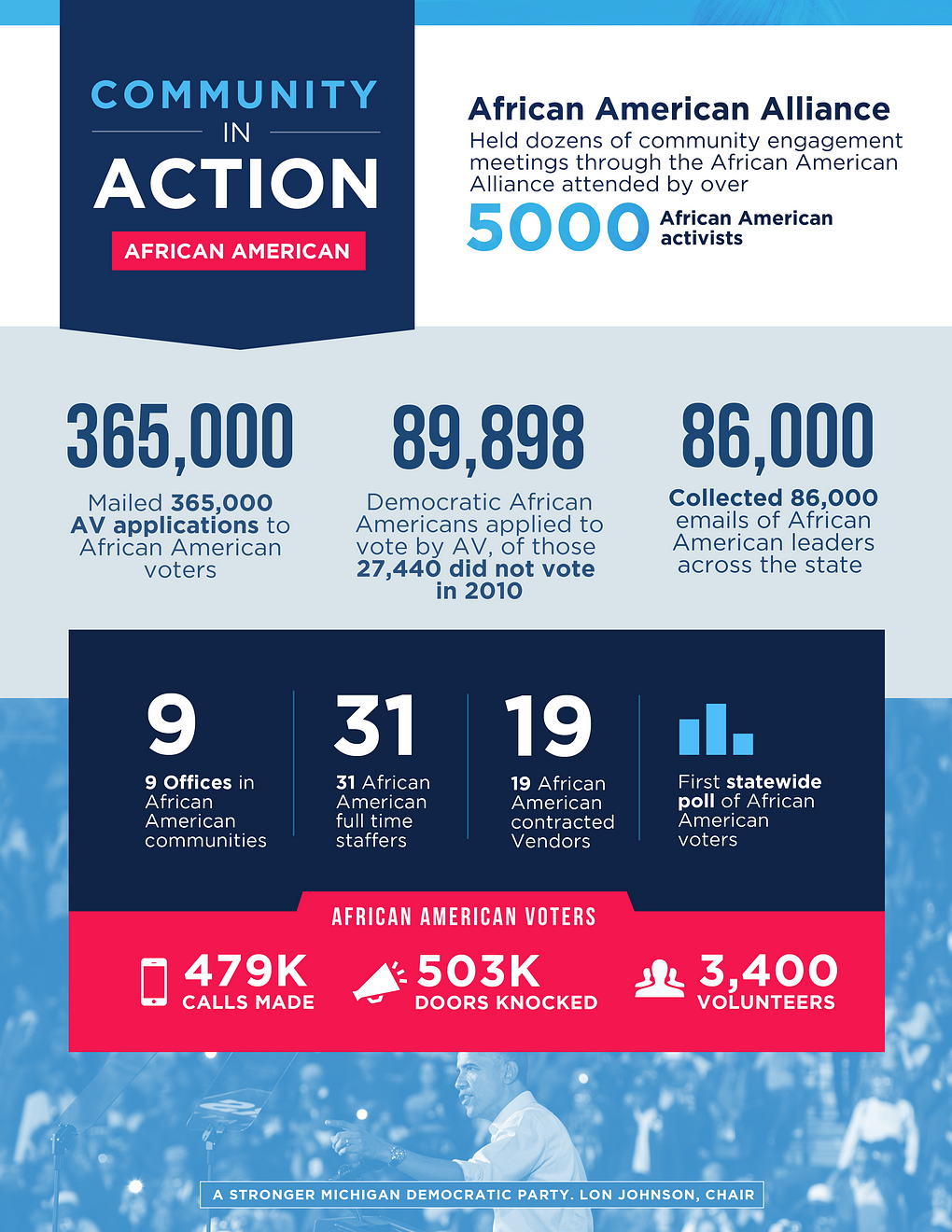“We have to do a better job of showing the voters in Michigan how we’re going to create a state where they can stay and succeed.”
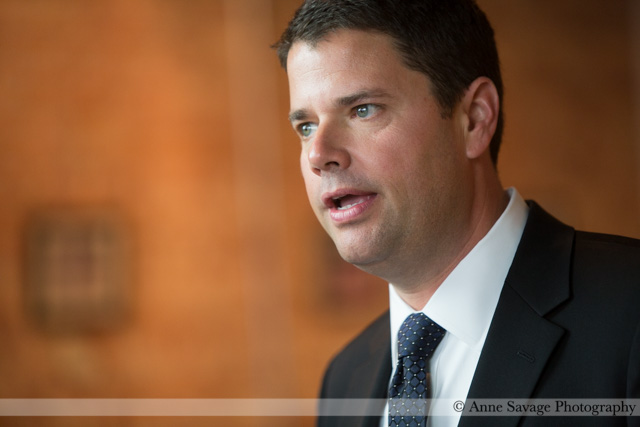
I first interviewed Lon Johnson almost exactly two years ago when he first ran for Chair of the Michigan Democratic Party. He ran a spirited campaign for Chair gaining support from the entire Democratic Congressional delegation as well as the major labor unions. In the end, incumbent MDP Chair Mark Brewer stepped down at the Convention, allowing Johnson to be elected by a unanimous vote.
During that first interview, Johnson laid out his vision for the future of the MDP and we revisited that vision in a second interview last fall right before the election. By and large, Johnson did what he set out to do in terms of expanding the party on a wide variety of fronts. Still, Democrats in Michigan – with the exception of newly-elected U.S. Senator Gary Peters – got clobbered on Election Day in November 2014.
Johnson has spent the past couple of months traversing the state on a listening tour of sorts. At the stops, which have been in towns from the Upper Peninsula all the way down to Detroit and everywhere in between, Johnson talks about what went right, what went wrong, and what needs to change if Democrats are going to be successful in the future. During these stops, he’s getting an earful. I have been to several of his visits and there is a seemingly endless supply of Democrats who believe they have it all figured out and want to both vent and educate the MDP Chair. What is most remarkable is that Johnson seems to truly want people to both unload on him and to share their ideas. He has equal amounts of humility about what didn’t happen and also great pride in what the MDP did accomplish.
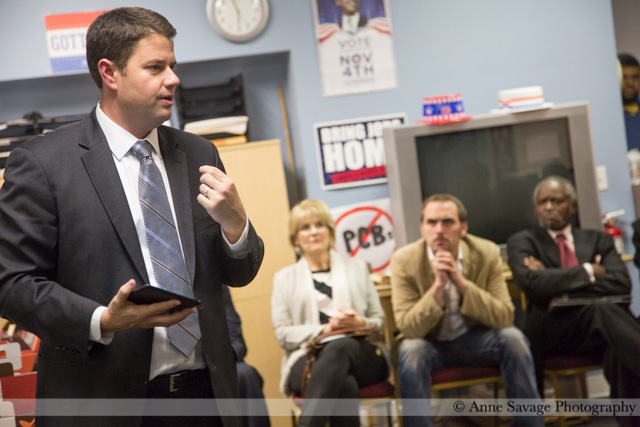
Johnson is running to keep his seat as Chair and the election will take place at the MDP’s statewide convention at the Cobo Center next Saturday, February 14th. I thought it would be helpful to sit down with him once again to get his take on what happened in 2014 and what the future of the MDP holds.
All photos by Anne C. Savage, special to Eclectablog.
I know that you’ve announced officially that you’re running for Chair again and I wanted see how you felt things went in the November 2014 election and talk about what you felt went right, what you felt like could have been done better and what you see the future looking like.
I think we did a good job of starting the process to build greater capacity at the Democratic Party. When you look at the metrics, our membership is up, our digital capacity has increased, our fundraising has broadened beyond just traditional sources. We’ve got to do better, though, to win. A lot of what I’m about to tell you isn’t just me throwing a dart against the wall and painting a target around it. We lost and we have to take lessons from that loss. We then have to keep what worked and improve upon that. And we have to throw out what didn’t and grow and win.
A couple of things sort of leap to the front here. One, we have to do a better job of showing the voters in Michigan how we’re going to create a state where they can stay and succeed. That is the question being discussed at the kitchen tables and in living rooms no matter if that person is from the U.P. or Detroit or Kalamazoo. “How do I stay in Michigan and succeed?” We are losing entire generations to Chicago, San Francisco, D.C., New York, Florida, Texas. And it’s because, in part, we’re not building that state. It’s not happening. And Democrats have to do a better job of explaining to people precisely what they’re going to get when they vote for a Democrat.
A few examples. Soapy Williams had a bridge, the Mackinac Bridge. People understood immediately the implications of that. Voters want to know what’s in it for them. Gov. Engler talked about reforming education. Now, whether or not you liked it or not, you understood that that’s what this man was about to do. Gov. Snyder had a message of reforming Detroit in his mind. Fixing Detroit and moving our state forward for business.
Again, what we have to show the people of Michigan is how we’re going to create a state where they can stay and succeed. The Democrats believe to do that you must invest and protect our greatest assets: our people, our land, our Great Lakes. And we have to be BOLD, we have to be very bold in showing the people of Michigan how we will do that. In my eyes, we have to do that in five different categories: Economics, education, natural resources, our infrastructure, and then how we relate to other governments; how the federal, state, local, county, and municipal governments all relate to one another. Right now we have terrific contrasts so that we can go out there and make. But we have to be bold.
Too often we rely on a national or even statewide organizations to tell us what to say to voters. But those issues are usually aimed at persuading specific types of voters. What we have to recognize is that those voters can be inspired and persuaded by bold ideas. Never before have we had a chance like this to really contrast ourselves with the Republicans. The Democrats believe in investing in people and the Republicans believe in investing in corporations. We believe that when you invest in people that the payoff will come in many forms. The Republicans have shown that they believe that investing in corporations will create a better Michigan. That’s a very clear dynamic that we should proudly stand behind and make that distinction.
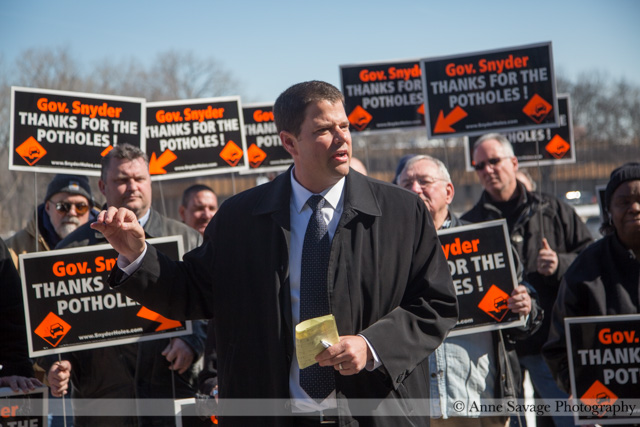
Looking back at 2014, we had one task at the Democratic Party – the Coordinated Campaign, that is. That was to turn out 180,000 Democrats that did not vote in 2010. That was the number that was agreed upon by the Schauer campaign, the Peters campaign, the State House, the State Senate, our Congressionals, and all of our major stakeholders. We saw a massive problem: we had 995,000 Democrats that didn’t vote in 2010. So we agreed that we would go after and approach and turn out 180,000. That was our goal. And the numbers came back two weeks ago showing that we, in fact, did that. We turned out 229,000 IDed Democrats that didn’t vote in 2010. These were people who were already registered to vote, they weren’t new registrants, who did not turn out in ’10. We don’t take a lot of solace in that fact. It suggests that there are other things we need to do to win. That approach didn’t win.
But in building that, we built an infrastructure that will serve our Party and our candidates for many years to come. We took our membership from 14,000 in 2012 to over 21,000 today. We took our emails from 100,000 to 500,000. We took our social media followers from 15,000 to 45,000.
Is that “Likes” on your Facebook page?
Likes on our Facebook page, Twitter followers, those sorts of things. Campaigns aren’t all about point-and-click but our job at the Party is, in part, to create the infrastructure that can be used later for our County Parties, our clubs, our municipal operations, and our candidates. We accomplished that and that is now within our infrastructure and can be used by everyone.
Also, we created 100 new websites for candidates. We massively expanded absentee voting which will pay dividends for us for many years to come. In 2010 we had about 260,000 Democrats who applied to absentee vote. In 2014 we had 398,000. A lot of studies have shown that once a voter votes absentee once, they’re more likely to do so in the future.
We need to think about our 2018 turnout problem right NOW in the 2016 cycle. So what are we doing to identify who will be our turnout targets in 2018 and how do we engage them in a year that they will be paying close attention – during a presidential election – and voting? How do we extend that participation in 2018? One of those ways can be with absentee voting. Turnout won’t be our problem in 2016, but there are ways that we can approach 2016 that can pay benefits in 2018. I’m talking about mechanics.
Again, we at the Party did, I think, a terrific job on bringing principals into the state of Michigan. Whether it was Biden for the Jeff-Jack Dinner or Bill Clinton for the Jeff-Jack or bringing principals to Michigan to campaign for us. They wouldn’t have come here if we had been divided or had we been disorganized or had we decided not to be Democrats. We take pride in that.
When you look back, you’ll remember during my race for Chair, I promised a number of things. One of them was that I would restructure the executive management of the Michigan Democratic Party. I said that we would create an Executive Director, we would expand the Executive Committee and work with them more, and that the Chair would be focused more on finance and media while the Executive Director would be focused on the day-to-day stuff which would build greater capacity. We did that.
 Second, that we would increase our digital presence and technology. We did that. Again, we went from 100,000 emails to 500,000. In the last five months of this campaign, we raised much more money online than ever before. That brings in a whole new crop of donors. The same goes for social media.
Second, that we would increase our digital presence and technology. We did that. Again, we went from 100,000 emails to 500,000. In the last five months of this campaign, we raised much more money online than ever before. That brings in a whole new crop of donors. The same goes for social media.
The third thing I promised was to help our candidates on the ground. Campaign-in-a-Box, if you will. You heard me talk quite a bit about that. There we offered up a free website for every single candidate. Every single candidate could have a website that could accept donations, one they could put their picture on, issues, and so forth. There were also the absentee applications that we sent out. We sent out over a million absentee applications. Now, for a candidate, what I mean by Campaign-in-a-Box, I mean how do we do things for candidates so that it takes that thing off of their to-do list? Sending absentee applications, that was something we did everywhere. That was something that we paid for from the Michigan Democratic Party that a candidate didn’t have to.
We also opened 43 offices around the state. When you compare that to what happened in 2010, it was light years ahead. And we did that, in many instances, in April and May and June. Were those offices all well-run, according to how those local candidates wanted? No. And that’s something we’ve got to get better on. That’s something absolutely we need to get better on.
Another thing I talked about was better inclusion of women and minorities. In part what we tried to do with absentee voting was to increase participation of women and minorities in voting. When you look at who has the greater logistical challenge to voting, it’s women and other people who work for a living. So when you increase absentee voting you do that.
MyAbsentee.com was another mix of involvement and engagement and technology. I mean, right here – [holds up his iPhone] – African Americans have a greater adoption of smart phone technology than any other group. Most people don’t know that. That was one way that we could extend the enfranchisement of that community that had not been. And we had thousands sign up through MyAbsentee.com.
The Win Machine came too late. I recognize that. It came too late. We’re still looking at the numbers but we had a fundamental problem with the Win Machine and that was that we used the same vendor for the Win Machine that we did for MyAbsentee.com. When we launched MyAbsentee.com, for three weeks we were working out the bugs. Any time you do something new and novel, there are going to be problems. We solved those problems so that, by October 1, it was up and running and anybody could use it providing that their Clerk accepted the applications. As soon as that was done we launched the Win Machine.
But, again, this isn’t just about looking at the 2014 cycle. These are tools we will use moving forward that will pay great dividends later on. My Win Machine was just launched way too late…
The Win Machine allowed people to canvass in their own communities, you basically gave them walk lists or call lists…
Right. They could campaign right from their iPad. It was launched, I think, on October 10, way too late.
Another thing that we did, you may have seen that letter that I put out a letter giving people 10 names. That was another Campaign-in-a-Box, if you will. We’ve got 4,500 precinct delegates, about 5,000 Democratic elected officials, and 20,000 Party members. What are we doing from the state Party to engage them in a way that lifts all boats? So, we came up with that letter. It was very expensive but it was one of those things that… we often hear that we don’t engage our precinct delegates. Shame on us. It’s not on them. We have to give them clear instructions and the tools to get those things done. And that’s another thing I want to talk about in ’15. We did that this past year and it was a start. We mailed out over 90,000 of those things. 90,000 targets to approximately 23,000-25,000 stakeholders in our Party. Gave them and easy “go do”. Ten people. Ten people that were in a half mile of your home.
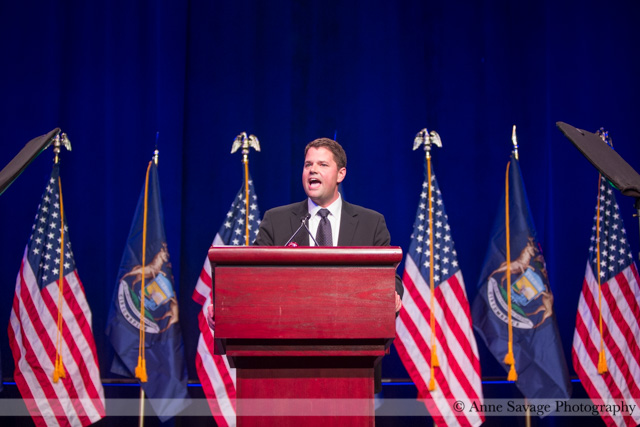
Looking forward, I think we have to do a number of things. We have to learn from ’14 and understand what we can do to start to solve the drop-off problem that we know will be there in 2016 and 2018. That involves a lot of understanding of the data. We’re looking at that now. And then we have to mechanically integrate that into our 2016 effort right from the start.
What’s apparent right now are three things. One, we have to be the party of ideas. When we don’t off up ideas or those ideas are small bore, we will not gain the attention or the support of the voters that we know is there.
Second, and this is not counter that, but we should be talking about big ideas like rail service. We should be talking about loan forgiveness. We should be talking about the President’s community college proposal. We should be talking about a water institute in Michigan that is the Harvard of showing the world… we should be the thought leaders on how to protect and use fresh water. It’s things on that scale that we should be talking about.
Third, we’ve got to work with our precinct delegates and membership more in the sense that, too often we go to the voters and say, “Hey, this is what you should care about” instead of understanding what that voter cares about and showing the differences between the two parties on those issues. In every single precinct there is a local issue that’s germane to that precinct, that’s highly salient. Whether it’s a contaminated creek, an eyesore of a junkyard, abandoned homes, three teachers that got laid off, what have you. We have to create a precinct structure that understands and that finds those issues out, communicates to the voters inside that precinct the differences in the two Parties on that issue. And then, that they have the tools to turn those voters out. That is a problem of capacity.
Republicans do a much better job than us on mail. So, the question is, we’ve got 5,000 different precincts, how do you do 5,000 different mail pieces? It’s a capacity problem. But we CAN figure this problem out but only if we engage with our precinct delegates in a real way and give them real responsibility. And, if they don’t accept that responsibility then we need to replace them with precinct delegates who will work. Right now we haven’t asked our precinct delegates to do a whole lot. You gotta ask them to do things, you have to make it measurable, give them the tools, and, if they are not doing, well then we have to go find another precinct delegate.
We need to hyper-localize, if you will. But, they’ve got to have the tools
So does that come down through the County Parties and the District organizations?
I think it’s got start at the state Party then go down through the County Parties and to the clubs. But we can’t just go to the County Parties and say, “Get this done.” You’ve got to give them the tools and the direction. “This is how it gets done, these are the tools you have…” And we’re not just talking about the precinct delegates but we need to create a system at the state Party level that helps YOU the County Chair. Help you find the likely recruits and who the people are who you should go after, and so on and so forth. And then we’ve got to give you the resources to approach them.
So, we have to come up with bold ideas. Then, at the same time, we need to lead locally with local issues that are important down to the precinct level. We also need to expand on our infrastructure. This is Michigan and there’s no reason why we shouldn’t have 50,000 members. None. None. We have over a million Democrats in the state of Michigan. Why can’t we get 50,000 members? that’s wrong. We can. And we will.
I’ve taken a different approach at the Michigan Democratic Party on membership. You may have heard that we’re giving out free memberships. The point behind that is that we approach likely Democrats who are active – whether they vote or volunteer or they’ve made a contribution – and we ask them to join the Party. Then they get a membership card. Then they get some emails. Then they get invited to some events. Only THEN do we ask them for $20.
Is that working so far?
Yeah, it’s working. Right now we’re at about 20,000 members and we’re analyzing continuously what happens in that process, what’s the rate of return, if you will. So far, it’s more than paying for itself. That not only makes our Party financially stronger, but it make us stronger organizationally.
People have buy-in at that point.
Right. People have buy-in. You can ask anyone about when I ran for State House. I was one of the leading fundraisers but I was also, at the same time, one of the most known candidates. Because, at every door that I went to, whenever I got somebody that was fired up, I’d ask them for $5. That was probably the first time that anyone had ever asked that person for money. And, second, they felt more bought in.
Another thing we need to do better at is giving our County Parties and our candidates access to those lists. Lists are only as good as they are used. It’s great if we have this database in Lansing but it’s no good if it’s not being used. Lists of volunteers and contributors are like a muscle. If you don’t engage with them, they will move on. And you’ve got to engage with them with real issues and local issues.
We’ve got half a million email addresses right now. We should be giving that to you, the County Chair. And we should be sending emails saying, “Hey, show up to this County meeting. Come meet X candidate or let’s talk about this issue…”
One of the things that I hear most from the Congressional and state legislative candidates was that the Coordinated Campaign’s focus was almost exclusively on the statewide candidates, Schauer and Peters. They felt like they weren’t really involved in the Coordinated Campaign. Was that by design? Was that something that you’d do again? What’s your perspective on that?
Well, again, the objectives of the Michigan Democratic Party as assigned to us and as agreed upon by everyone, was to increase turn out of Democrats. That if we didn’t turn out those Democrats, it didn’t matter how many independents a Congressional candidate were to persuade, they were going to lose. In many ways, tactically and strategically, we were assigned to do one thing and that was to turn out Democrats who didn’t typically vote in midterm elections. If we were to scatter and take on other missions, that effort would have been hurt. Every candidate for office in every county has their own objectives and they should pursue those. However, collectively we had to turn out those Democrats. If we didn’t, it didn’t matter what else happened.
How do you feel you did in engaging minority groups, especially in Detroit? That was a fairly major goal for you when I talked to you before. It seemed when I talked to you the last time right before the election that a lot of resources had been expended. Do you feel like you got more engagement and participation from the minority community?
I believe we did. First off, we recognized that we had to do a better job earlier in the minority community. We could not wait until October. So we did a number of things starting in the fall of ’13. We opened up nine offices around the state in African American neighborhoods. We hired 31 full-time African American staffers. We had 19 African American vendors. We conducted the first-ever African American-only poll in the state of Michigan. We knocked on the doors of 503,000 African American homes and made 479,000 calls. We had 3,400 volunteers. For the first time we created something called the African American Alliance, a group of African American leaders and stakeholders. Until last year, we had very little communication infrastructure in the African American community. I think we something like 300 emails. We now have 86,000 African American leaders on an email list. That is an enormous achievement that will build greater capacity. We now have an African American Alliance Facebook page with 6,600 followers. We mailed out 365,000 absentee voter applications to African American voters of which 89,000 applied to absentee vote. Of those 89,000, 27,000 of them didn’t vote in 2010. We didn’t win but we are on track to building greater capacity for the Party for ’16 and for ’18. We have to keep going.
It really shows in the numbers. I saw an interactive map online that showed 2010 votes vs. 2014 votes and every county, as far as I could tell, Democrats turned out in larger numbers this year. That shows me that you were, ultimately, successful. Not as successful as you wished to be, of course, but you did that.
Again, our collective goal was to increase the turnout of those sporadic voters by 180,000 and, to that, extent, we pulled out 229,000. We did our job and we should take a great amount of pride in that. However, we didn’t win so we have to understand why.
But, you know, we should take great pride in electing Gary Peters. The ONLY new Democratic Senator. Gary is an incredible candidate but we contributed massively to that victory.
One of the more of the more valid criticisms of the Schauer campaign that I’ve heard is that, while he was on the right side of the issues – whether it was Emergency Management or women’s issues or what have you – he really didn’t articulate specific plans that people really could get behind. They wanted more than for him to just say that, you know, we need to end Emergency Managers in Michigan. They wanted to understand what you replace that with and he didn’t do that in a way that was effective, I don’t think. And I wonder how much impact the MDP can have with something like that. At some point it comes down to you have the candidate that you have and you have to rely on them to craft a message that appeals to voters.
Ultimately you have to understand, mechanically, the job of the Party. The job of the Party is to identify Democrats and get them to turn and vote. And also to recruit candidates. But it is up to each individual campaign to decide how they are going to persuade and message to independent voters. I did not tell Gary Peters or Mark Schauer or Gretchen Whitmer or Tim Greimel how to run their operations in terms of which voters to target and what their messages should be to persuade. That’s not the role of the Party. It’s the role of each of those campaigns.
What our agreed to role was those 180,000 drop-off voters which is why we were so aggressive and insistent that our Coordinated Campaign offices focused on those voters. Again, the leadership from those campaigns were in that room when we decided on those goals. So we all own this.
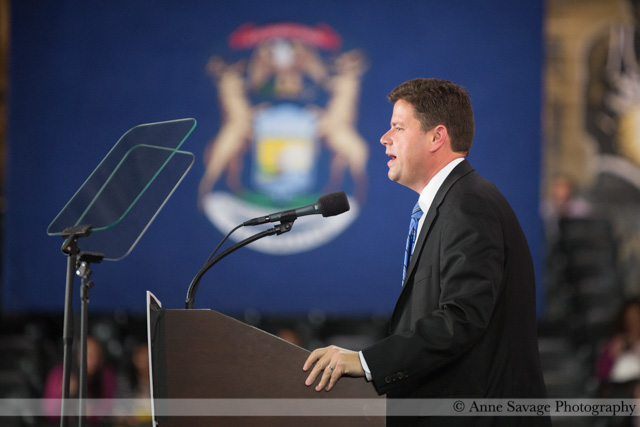
No primary for the governor’s race, no primary challenge there. Would you do that again?
Well, first off, this was not just Lon Johnson going in a room and coming out with plans.
Understood.
There was a collective decision made that primaries, going into this cycle against an incumbent governor with all of the advantages that incumbency brings, would be difficult. It would make it harder for us to come together. I’ll give you a prime example: It would have been very difficult for us to open offices in April, May, June, if you had had primaries in the governor’s race and the Senate race. So it allowed us to raise resources earlier and to deploy those resources earlier. It also allowed us to bring in national figures earlier.
In 2018 it will be a very different year. We are looking at an open seat. In many ways primaries will only strengthen our candidates and our Party.
I think that’s one of the arguments with Schauer is that he would have been a stronger candidate if he had had to answer some of the questions then that were later posed to him to him in the General Election.
There are positives and negatives. But, again, we lost. So everyone has to look in the mirror – me no less than anybody else – and we have to understand what happened here. But, we kept an incumbent governor to 50.9%, a man who had every advantage that there was to have in what we now know to be a big Republican year.
Yeah, it wasn’t just Michigan!
No. When you look at other states and what could have happened here, we actually did pretty well. Other states who laid up on certain races, the effect down ticket was enormous.
What do you do in 2015 in preparation for 2016? Will you be involved with, say, the ballot proposal to raise the sales tax or things like that?
Mechanically what we’re going to do is go into the Convention on February 14th and when we come out what I hope to see is a couple of things. One is what are we doing on policy? We need to create some committees and come out put together the policies that we will advocate for to create a state where we can stay and succeed. So, we need to develop those policies. Second, we need to develop our precinct delegate and membership programs in ways that we’ve never done before. We have to come up with a structure that engages those communities now and starts to build. Third, we need to involve more people in candidate recruitment and fundraising and expansion of duties, if you will. When you look at mechanically, precinct delegates, membership, fundraising, engagement of the African American community and women, we have to engage more people and move those communities forward for using ’16 to build a better organization for ’18. Essentially we need to draft on the greater interest a presidential election year brings to better position us for ’18.
I have to say that I feel right now that Democrats are pretty engaged. When I go to meetings I feel like there’s energy. People are not demoralized.
I was just in the U.P. and there were more people at the meetings this year than there were in February of ’14. G.T. Long and I were up there and we were shocked. And, we heard that, yeah, they were angry. Absolutely. They were full of ideas of how to do it better, but they weren’t in any way, shape, or form not willing to stay engaged in the fight.
I see that, too, so that’s encouraging.
One thing I thought of as I heard our president when he was at the Ford plant recently was that’s a speech I wish he would have given in July. He was full-throated in making the case as to why the Democratic Party’s and his ideas are better than the Republican’s. In many ways when I was there listening I wished we would have had that in July. Now, we have to build that here in Michigan. We have to build that policy difference.
Right before President Obama went I stage, I talked to him privately and he congratulated us on running one of the better Coordinated Campaigns in the country and delivering Gary Peters. He praised our efforts here in what was admittedly a very difficult year in delivering Gary Peters, the new only Democratic Senator in the country.
So, getting back to what I want to do, when I ran for the State House, there were five counties and I had 70 townships. I did not have the capacity to understand and know what the individual issues were in each one of those 70 townships. We need to build that capacity and address those issues in a very local way to create a dichotomy between us and the Republicans. There are myriad ways that those local issues are very salient to showing the dichotomy between us and the Republicans. So, instead of us going to the voters and telling them, “You should care about X, Y, or Z”, we need to understand what that voter cares about and show them the difference between the parties. What THEY care about. And that is a capacity issue and we have to do a better job of empowering precinct delegates to understand what those issues are and then giving them the tools to campaign on those issues.
Like I said, I really sense that there’s a lot of energy still, which is a bit surprising to me. I really thought that people would be more demoralized. Are you seeing that as well?
I think it’s a recognition that what we do is important. Look, who holds office is important and that’s why we do the work that we do. These issues are not going away. Income inequality. Education. Building a state where we can stay and succeed is an important task and it’s being made worse by these Republican actions. And we have to do a better job of showing the people of Michigan how we’re going to create that state where they can stay and succeed.
Click the infographic below for a larger, expanded version.


